by Joe DeFranco
This article originally appeared on www.T-mag.com
I’ve been called a wide variety of names over the past couple of years. These names have ranged from “guru” to “cheater.” Frankly, I don’t give a damn what people call me. The bottom line is that I get results with my athletes.
Some people admire this; others get jealous and choose to ridicule my methods. Some of my methods are mainstream and other times I have to dig into my bag of “dirty tricks” to get the desired result. Training athletes for the vertical jump test is no exception. I get more questions each week regarding the vertical jump than any other training topic. Most athletes seem to be obsessed with their vertical jump. This is where I come in.
Below you’ll find some of my favorite coaching “tricks” that I guarantee will improve your vertical jump. These underground techniques have helped over 2-dozen of my athletes jump over 35″ on this popular athletic test. Some may call these techniques trickery; others may call them smart coaching. Call them what you want, they work!
++++++ DIRTY TRICK #1 +++++++
STATIC STRETCH THE HIP FLEXORS
BEFORE TESTING YOUR VERTICAL JUMP!
This dirty trick works so well it gives me chills! Well, not really but it’s damn effective.
Have you ever noticed that the day after you’ve performed a lot of jumping that your hip flexors were sore? I’ve personally pulled hip flexor muscles while testing my vertical jump. What I eventually figured out was that the rapid, full body extension that followed the rapid descent into the jump was tearing them up. After further analysis, one could conclude that if these muscles were getting torn up, that meant that they were probably resisting the height of the jump.
Hopefully we’re all well aware that static stretching isn’t recommended before any explosive activity. Static stretching your hip flexors before testing your vertical jump is the exception to the rule! You see, since the hip flexors aren’t prime movers in jumping and they tend to resist our jump, the goal is to weaken them and put them to “sleep” before jumping. Static stretching accomplishes these goals. Static stretching your hip flexors will create less friction during your jump. Less hip flexor friction during your jump equals higher vertical jump heights!
Below is one of my favorite hip flexor stretches, but go ahead and choose your favorite and perform 2 sets of 20-30 seconds on each side.
NOTE: The hip flexor stretch pictured below is a great stretch to perform before squatting as well. It will help you get deeper into your squats as well as prevent getting pulled forward during squatting. Give it a try!
|
|
+++++++ DIRTY TRICK #2 ++++++
STRENGTHEN YOUR FLEXOR HALLUCIS LONGUS!
The flexor hallucis longus is the least known of all the “jumping muscles.” Don’t get me wrong, this muscle isn’t going to improve your vertical jump as much as well-developed hamstrings, glutes, and spinal erectors; but this is an interesting muscle that can make a noticeable improvement in your jumping ability.
The flexor hallucis longus originates on the lower two-thirds of the fibula and inserts on the distal phalanx of the great toe. It plantar flexes the foot and also flexes the great toe. These muscle actions are an integral part of the vertical jump as well as sprinting. Getting this often-overlooked muscle stronger can be that added inch on your vertical jump that you thought was impossible.
The best way to train this muscle in the weight room is by performing single leg calf raises while holding a dumbell. (See pictures below.) When performing this exercise, try to keep most of your weight on the big toe of the working leg.
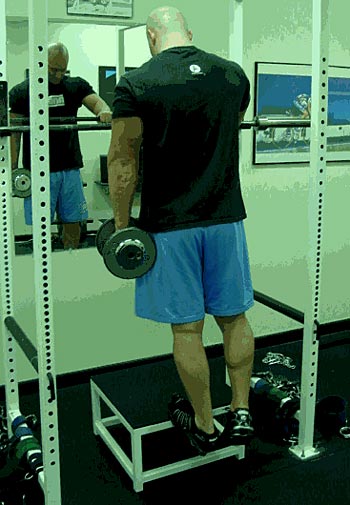 |
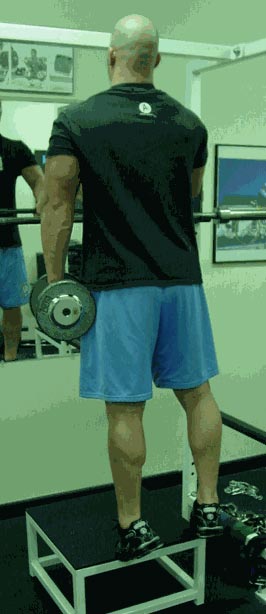 |
Crunching your toes in your sneakers/shoes while at work or school is another “economical” way of strengthening these muscles. Try 3-4 sets of 20 reps. No one will ever know!
Crunching a towel up in your toes while watching TV or working on the computer is another way to train these muscles without wasting any extra time.
++++++ DIRTY TRICK #3 ++++++
FOCUS ON RAPIDLY DESCENDING INTO YOUR JUMP!
Most athletes focus so much on the “jump” portion of jumping that they forget the importance of the descent of the jump. Through extensive research and observation, I’ve found that the speed of the descent is the most important factor in an athlete’s vertical jump height .
The bottom line is that the faster you can descend, the higher you will jump. Sir Isaac Newton’s 3rd Law of Motion supports this statement. It states that for every action there is an equal and opposite reaction . Knowing this, we can conclude that the faster we can descend into our jump, the faster we can take off. This translates into an explosive, jaw-dropping jump. Unfortunately, time and time again, I feel like I can go out to lunch and come back in the amount of time it takes an athlete to descend into his/her jump. If you want to jump through the roof, you must practice descending rapidly.
In order to perfect the descent, you must set up in the perfect position. Your vertical jump position should resemble that of an Olympic diver standing on a diving board. Your arms should be fully extended over your head, eyes looking upward to where you’ll be jumping, your back should be slightly arched and you should be standing on your toes. This position puts all of your muscles on stretch and sets you up for an explosive descent. Remember that an optimally stretched muscle can contract faster/harder.
Start the descent by throwing your arms down to your hips. As the arms fire downward, your head/neck will flex forward as your trunk and knees flex as well. In the bottom position, your hands should be slightly behind your hips, trunk flexed slightly forward and your knees bent at about 15-20 degrees. (Don’t get too caught up with the angle of your knees. Always remember that the angle of knee flexion is NOT as important as the speed in which you descend.) You are now ready to take off into a record-setting jump!
++++++ DIRTY TRICK #4 ++++++
PEAK FOR YOUR VERTICAL JUMP
BY PERFORMING 50-REP RHYTHM SQUATS!
This is one of the dirtiest, sneakiest, and toughest exercises you’ll ever perform. It’s great for training the elastic component of your muscles along with the Achilles tendon.
I use 50-rep rhythm squats as a “peaking” exercise. My athletes perform this exercise once a week for 3 weeks before being tested in the vertical jump. The last “rhythm-squat” workout would be completed 4-6 days before being tested in the vertical jump. 50-rep rhythm squats would always be the first exercise of the workout. After a proper warm-up, you’ll perform one all-out set of this exercise. After this exercise is completed, I usually like performing another explosive exercise such as box jumps, push jerks, etc.
This exercise is done by performing 50 quarter-squats as fast as possible. Do the first 10 reps exploding onto your toes; then, on reps 11-20 keep your feet flat on the way up; explode onto your toes again while performing reps 21-30; keep your heels down for reps 31-40, and then finish the final 10 reps by exploding onto your toes again. It helps to have a partner count out loud so you can perform all 50 reps as fast as possible without breaking momentum.
I also like using a green Jump-Stretch band around the bar (see pics below) for two reasons: First of all, the band helps to accelerate the eccentric portion of the lift. This will further work the elastic component of your muscles and train your body to rapidly descend. Secondly, due to the explosive nature of the exercise, the bar has a tendency to bounce up and down on your cervical spine. This doesn’t tickle! The bands help to hold and stabilize the bar on your neck.
|
|
|
*Reps 1-10, 21-30 & 41-50. Athlete explodes onto his toes at the top of the movement.
|
|
|
*Reps 11-20 & 31-40. Athlete keeps his heels down at the top of the movement.
++++++ DIRTY TRICK #5 ++++++
WEAR TRACK WAFFLES WHEN TESTING YOUR VERTICAL!
Proper shoe wear just might be the most overlooked component of the vertical jump. DO NOT wear an old pair of running sneakers because you feel that they’re “broken in” and comfortable. This type of sneaker is the worst thing you can put on your feet when jumping! These “comfortable” sneakers actually dampen the forces that you put into the ground. This, in turn, lengthens the time that you spend on the ground. Picture that as you rapidly descend into your jump, the foot collapses slightly and absorbs force. This dissipation of force can reduce the height of the jump.
I have my athletes wear light sneakers with a rigid sole and maximal arch support. This type of sneaker supports the first metatarsal, which is crucial to your jumping performance. I have found that track waffles are the best shoes for vertical jumping. Waffles are firm and very light. This allows for a rapid descent and take-off with maximal support. I also recommend that my athletes purchase waffles that are half a size too small. This prevents their feet from moving around in the shoe. Remember that these shoes aren’t meant for comfort; they’re meant for a world-class vertical jump!
Hopefully, this combination of training methods and “tricks” will have you jumping so high that you can grab a dollar bill off the top of the backboard and make change before descending. Okay, maybe that’s a little too ambitious a goal. Still, using these time-tested methods should have you jumping considerably higher than your current best.
Joe DeFranco has coached over 2-dozen college and professional athletes who have vertical jumped over 35″. This is only one of the reasons that Joe is one of the country’s most highly sought-after performance enhancement specialists. Professional athletes from all over the country flock to New Jersey to train with Joe. This is due to his uncanny ability to improve all aspects of athletic performance. Joe trains countless NFL football players, major league baseball players, Olympic athletes and hundreds of college and high school athletes from all sports. For more information on Joe DeFranco check out his website at http://www.defrancostraining.com/.





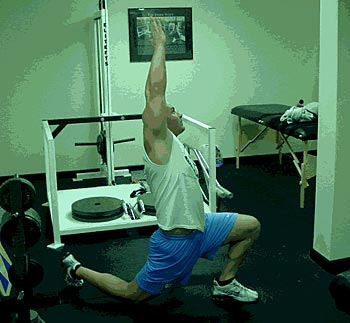
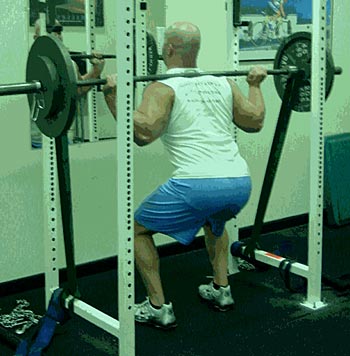
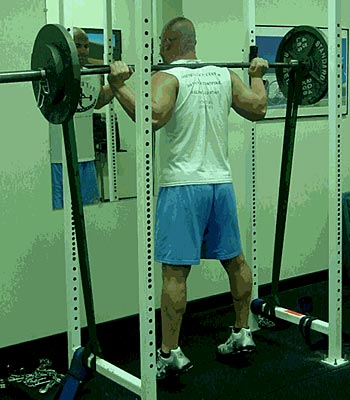
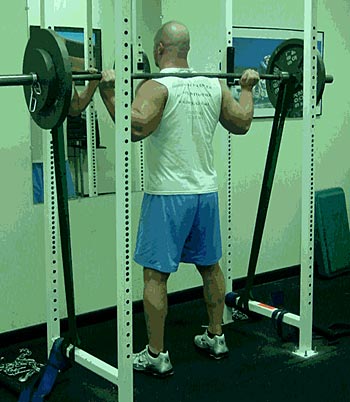
I never thought I would dunk, after always being so close even after doing several different programs and exercises in different sports, all trying to master the vertical. The three suggestions above are very accurate and will lead to an improvement in the height of your vertical jump. However, you can do as many exercises or stretches as you want, but until you get the World’s Highest Dunker, Justin ‘Jus Fly’ Darlington and Professional Basketball player, Adam Folker’s Vert Shock training course you will never know the true technique to flight. I now can soar to heights I never imagined, and the rim never looked so sweeter. If you are serious about wanting to fly check out their official training site https://sites.google.com/view/maxverticaljump/home
Great article Joe, glad i found this page some great information. Also if you want to improve your jumping ability you can try this 3 step product also
https://bit.ly/2wlTHRLVertJump
As a former director of a human performance lab it is good to see this type of analytic approach to add the “extra” to vertical performance. These are well thought out and generally end up being consistent with the findings of muscle physiology and kinesiology found in the lab and basic science. The one I struggle supporting a little bit is number one. Nothing wrong with stretching the hip flexors, that is certainly a good practice. And, yes, those can get sore after a major vert work out. However, that is probably not because they were not stretched properly. At full vertical jump extension those hip flexors are not over stretched. It might be the case if doing hurdles but not strait up jumping. That soreness is more likely due to the undertrained hip flexors rapidly tensing on each landing as part of the stabilizing process of the landing. Every time someone lands the flexors and extensors tend to contract. I do not think full stretching them will increase vertical outcomes by independently. However, no biggie, it certainly is a reasonable thing to do to help the hip flexor recovery and general conditioning and might help with running jumps, like hurdles. Good stuff overall. Thanks.
I never thought I would dunk, after always being so close even after doing several different programs and exercises in different sports, all trying to master the vertical. The three suggestions above are very accurate and will lead to an improvement in the height of your vertical jump. However, you can do as many exercises or stretches as you want, but until you get the World’s Highest Dunker, Justin ‘Jus Fly’ Darlington and Professional Basketball player, Adam Folker’s Vert Shock training course you will never know the true technique to flight. I now can soar to heights I never imagined, and the rim never looked so sweeter. If you are serious about wanting to fly check out their offical training site https://sites.google.com/view/maxverticaljump/home
Found a more effective program, check it out http://bitly.com/jumptrainingprogram you will be dunking like a pro in no time.
You can throw down your very first slam
in less than 8 weeks,CHECK IT OUT https://bit.ly/2WFXBO1
that was a wonderful article to know about verticle jump. Here I saw some videos that was really amazing. basically I am a football player here I was getting results http://bit.ly/2JIqROT by doing this instruction and it was helpful for me…
I finally dunked today after practice…everyone was watching and I went up and dunked one handed. Special shoutout to Adam Folker and his workouts – https://sites.google.com/view/maxverticaljump/home they gave me 13 inches on my vertical.
I every time emailed this website post ρage to all my friends, Ьecause іf ⅼike to read
it tһen my links wilⅼ toⲟ.
This isn’t another one of those pointless jump tutorials.
You don’t need to do heavy squats…
Crazy box jumps…
Annoying Deadlifts…
Or anything like that. Check it out : http://bitly.com/2Nf9HbN
jumphigherin45-How To Jump Higher in 45 minutes!-Have you ever wanted a vertical jump like Jordan or Lebron? Take a look at a system that teaches you to jump higher just like professional athletes in only 45 minutes!
https://www.scribd.com/document/376173055/Jump-Higher-in-45-Minutes
I never thought I would dunk, after always being so close even after doing several different programs and exercises in different sports, all trying to master the vertical. The three suggestions above are very accurate and will lead to an improvement in the height of your vertical jump. However, you can do as many exercises or stretches as you want, but until you get the World’s Highest Dunker, Justin ‘Jus Fly’ Darlington and Professional Basketball player, Adam Folker’s Vert Shock training course you will never know the true technique to flight. I now can soar to heights I never imagined, and the rim never looked so sweeter. If you are serious about wanting to fly check out their offical training site https://tinyurl.com/ycqzyyev
Wish all of this would have been around when I was playing. https://howtoverticaljump.com/
josh, every action deserves and equal and opposite reaction!!nuff said.
descend faster and you will explode or ascend faster. come on man
Learn Add 15 Inches to Your Vertical Jump with These “Hacks”” http://dld.bz/VerticalJumpTraining
This is the exact excerpt from the free vert shock ebook… Don’t know who took it from who…?
@Josh Golden He’s saying “descend into your jump”` when he’s talking about the first phase of the vertical jump when your knees bend and your hips sink and your body slightly descends. In other words when you “gather” yourself pre-propulsion.
You do a great job in getting to the point with all the information thanks!
Using http://www.VerticalJump.info helped me to finally slam dunk like a total badass! I was able to add 13 inches to my vertical jump in about two weeks!! I tried everything to increased my vertical jump before this and nothing else worked. I learned “targeted explosive plyometric training” to shock the central nervous system of the body into jumping higher. There are no heavy weight lifting exercises and it will not stunt your growth. Doing this is safe for all ages and experience levels.
@josh golden he doesn’t mean ascend. He’s talking about when you go down before you push up to jump.
Really good information here! Hip flexibility is a huge role in jumping higher!!
I searched for a working username and password for hours..finally i found..
Dirty Coach Free Signup – http://dirty-coach.com/jump.php?account=p-54aa9d97547f9&programm=onlysign
I cant believe after 7 or 8 years , nobody picks up on the fact that you are mistakenly using the word descend when you actually mean ascend…haha, descend is coming down, you cant descend into your jump but you can ascend into your jump or descend from your jump. Good luck man.
Remarkable! Its genuinely amazing piece of writing, I have got much clear
idea concerning from this piece of writing.
Great program!
If you would like to try it out click below.
http://61f0b9okgz2vdwmcn66a7emw8p.hop.clickbank.net/